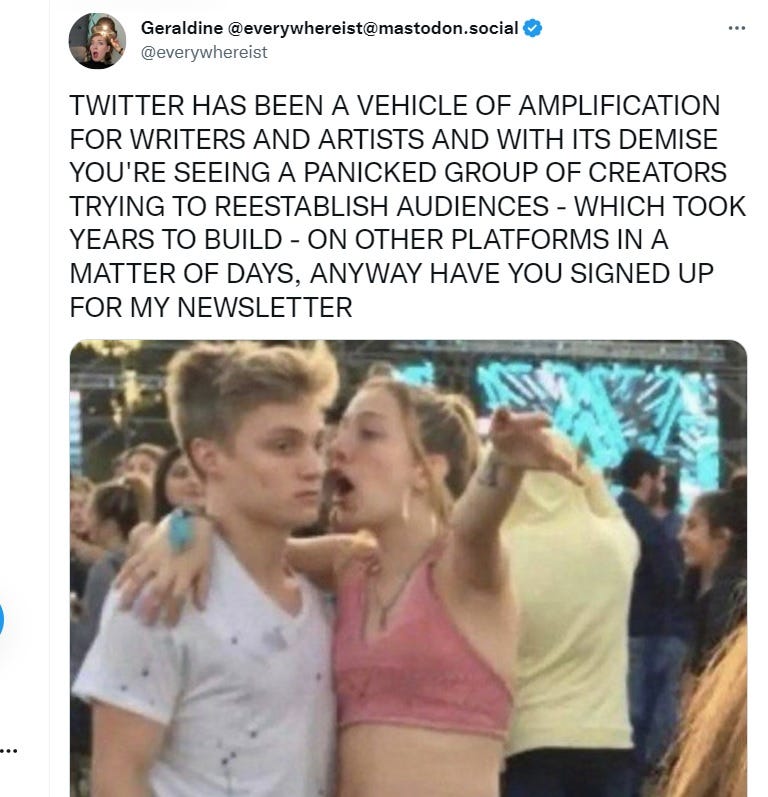Why journalists are so desperate to find a Twitter alternative
Twitter has operated as the primary venue for writers to take their audiences with them as they move from job to job.
Welcome! I'm Simon Owens and this is my media newsletter. You can subscribe by clicking on this handy little button:
Let’s jump into it…
Why journalists are so desperate to find a Twitter alternative
I know this is largely anecdotal, but I haven’t seen a significant decrease in my tweet impressions over these last few weeks; if anything, they've ticked up slightly. If there's a mass migration away from Twitter, it's not showing up in my stats. In fact, publicly-available data indicates that Twitter usage has actually spiked since Elon Musk closed his acquisition of the platform.
The thing about Twitter is that it's a fantastic product, and there's no social network exactly like it. There’s no other place you can go to engage in real-time discussion around breaking news, politics, sports, and entertainment. You could argue that Reddit was a better Digg and that Facebook was a better Myspace, hence why their users migrated to the new platforms. But what's the better version of Twitter?
That being said, there are genuine reasons to question the long term health of Twitter. Musk himself has acknowledged that its revenue base cratered as advertisers fled. One viral post from a brand that claimed to spend $750k a month on Twitter ads detailed the deterioration of the company’s promotion tools — a deterioration that was only exacerbated after Elon fired key sales staff.
What’s more, there are signs of strain to Twitter’s tech infrastructure. Two-factor authentication hasn’t been working for days, spam bot activity has increased, and many users have spotted glitches in the app. It’s not inconceivable that this confluence of factors, as they worsen, could drive users away en masse. It wouldn’t be the first time that such a thing happened to a social network.
If you’re just a casual user of Twitter, then chances are that you’re watching all this drama unfold with indifference — you might even be enjoying the front row seats to the potential collapse of a platform with hundreds of millions of users, run by a guy you don’t particularly like. But there is one group that’s reacted to all the calamity with a sense of panic and frustration: journalists.
That’s because Twitter has served, for more than a decade, as the de-facto platform on which journalists built their own personal followings outside their places of employment. While mainstream media outlets have historically been reluctant to help grow their reporters’ personal brands, many have acquiesced to allow Twitter handles to appear in bylines and author bios. Twitter has operated as the primary venue for writers to take their audiences with them as they move from job to job.
As such, a Twitter following has become its own form of social currency. Journalists use it in their salary negotiations. Publishers use it when deciding whom to poach from rival outlets. And when a star reporter does decide to strike off on their own to build a business within the Creator Economy, they usually leverage their Twitter following as a launching pad. It’s not a coincidence that many of the writers on the Substack leaderboards also have large Twitter followings.
Now put yourself in the shoes of your average journalist: you’ve spent the better part of 12 years telling all your readers to go follow you on this one platform, and now you’re confronted with the very real possibility that the entire platform could collapse in the next few weeks. What happens to all that social currency you’ve built up?
Hence why nearly every journalist in your tweet stream has been frantically testing out alternate platforms, pushing as many of their followers to them as possible. For many, the obvious solution has been to send followers to a newsletter signup form, which would allow them to establish more direct ownership of their fans. The tech reporter Taylor Lorenz, for instance, has changed her Twitter user name to “SUBSCRIBE TO MY SUBSTACK.”
Of course, not all reporters have this luxury; in recent years, outlets like The New York Times have rolled out new policies barring their employees from operating personal newsletters without prior approval. These rules were essentially a short-sighted effort to prevent star journalists from launching their own competing media outlets, and they’re now hindering their ability to stem any losses from Twitter’s potential collapse.
We’ve also seen journalists launching accounts on so-called Twitter “alternatives” like Mastodon, Hive Social, and Tumblr. Quite a few have expressed disappointment that these other platforms don’t come close enough to mimicking Twitter’s real-time and open functionality.

So how have I been reacting to Twitter’s potential demise? Well, I happen to think Elon is kind of an asshole with a penchant for stealing artists’ work and spreading misinformation, and I’m not that excited about the prospect of giving him my free content. And as a guy who’s always thought Twitter got a bad rap when users described it as a “hell site,” I’m saddened by the idea that it could soon become another Myspace or Friendster.
But I don’t share the same sense of panic as many of my peers. That’s because I’ve spent the better part of eight years growing my newsletter audience — to the point that it recently surpassed my Twitter following in size. I’ve also diversified my following across my podcast, YouTube channel, Facebook Group, and LinkedIn account. If Twitter collapses tomorrow, I feel confident that my content will continue to find an audience.
To be sure, I’ve also been playing around with various Twitter alternatives, which I’ve mostly found lacking. Mastodon, for instance, provides a pretty clunky experience, and while I’ve been impressed with the simple elegance of Tumblr, I’ve also had a hard time finding other like-minded colleagues to follow on the site.
In the meantime, I still spend an inordinate amount of time on Twitter. The platform continues to be one of the best watering holes on the internet, and I genuinely like the community there. As one user recently put it, “This wasn't just a hell site, it was a hell home.”
What do you think?
Ever want to pick my brain?
So I get a lot of email inquiries from startup founders and media operators who want to know if I offer any kind of consulting services. In most cases, they want high level strategy advice on how they can better grow their audience or monetize their content.
For the most part, I’ve had to turn these opportunities down, mostly because I didn’t have a way to incorporate consulting into my workflow. It takes a lot of time to compile my newsletter and podcast each week, and I didn’t want to compromise their quality just so I could make some extra money.
But then Substack invited me to beta test a new tool for scheduling one-on-one phone calls with writers. Basically, it’s integrated with my Calendly, and it provides an incredibly simple way to incorporate high-level strategy consulting into my already-existing workflow. If this is something that interests you, then you can book a call using the link below:

Book a meeting with Simon Owens
Quick hits
“I think the most important thing about us getting into profit is that we’re producing highly differentiated journalism that you couldn’t get anywhere else about this city – and we’re doing it on a consistent basis.” [Press Gazette]
I like the fact that Puck placed all its focus on hiring a very small number of star reporters and built a business around their personal brands. This is the complete opposite approach of sites like BuzzFeed and Vice, which took on hundreds of millions of dollars in VC funds so they could hire huge staffs. [Adweek]
It’s amazing how many successful newsletter entrepreneurs trace their original inspiration back to Morning Brew. An entire generation of bootstrapped media companies got their initial lightbulb idea after reading it. [Beehiv]
For the first time in history, B2B media is sexy. [Press Gazette]
I was interviewed on a podcast! I went on to say not-very-nice things about “Web3.” [Media Voices]
ICYMI: How an engineering student accidentally started a thriving science news site
Hüseyin Kilic grew Interesting Engineering into a media behemoth with over 15.5 million social media followers.
Do you like this newsletter?
Then you should subscribe here:
Simon Owens is a tech and media journalist living in Washington, DC. Follow him on Twitter, Facebook, or LinkedIn. Email him at simonowens@gmail.com. For a full bio, go here.




This is an interesting take regarding audience building. While traditional communities are built around shared ideas, algorithms have changed a lot of that. Twitter is not immune, but even platforms like Substack don’t offer the tech push behind readability, relatability and trending content. Will be interesting to see how this plays out.